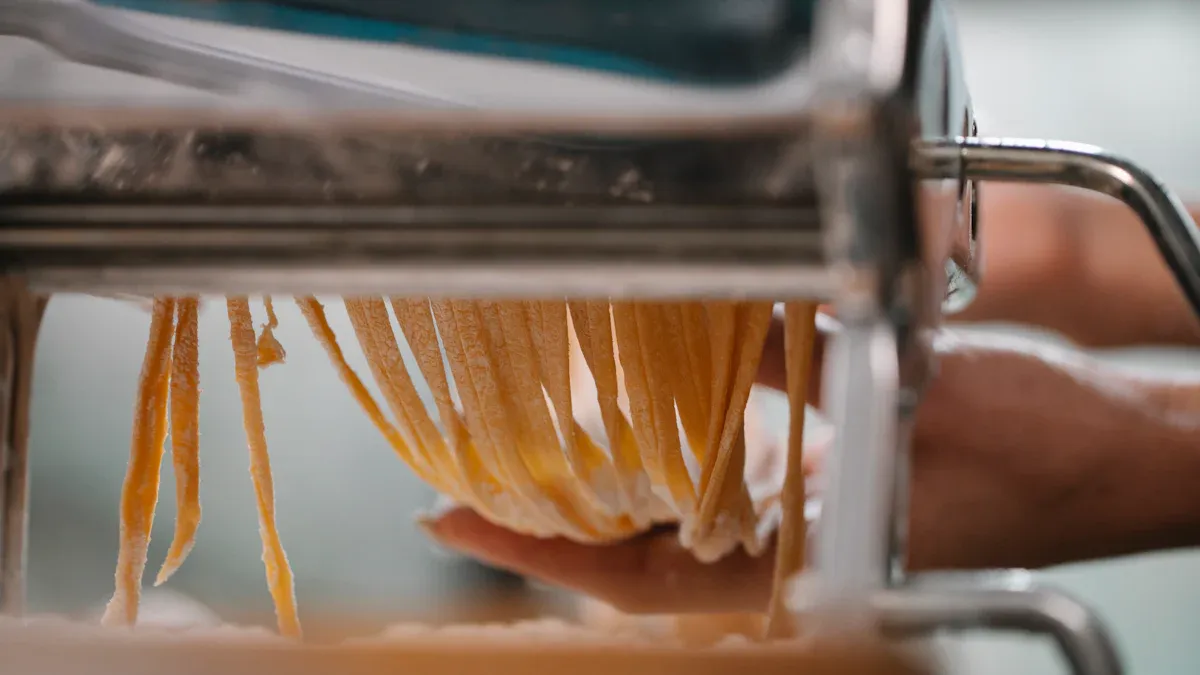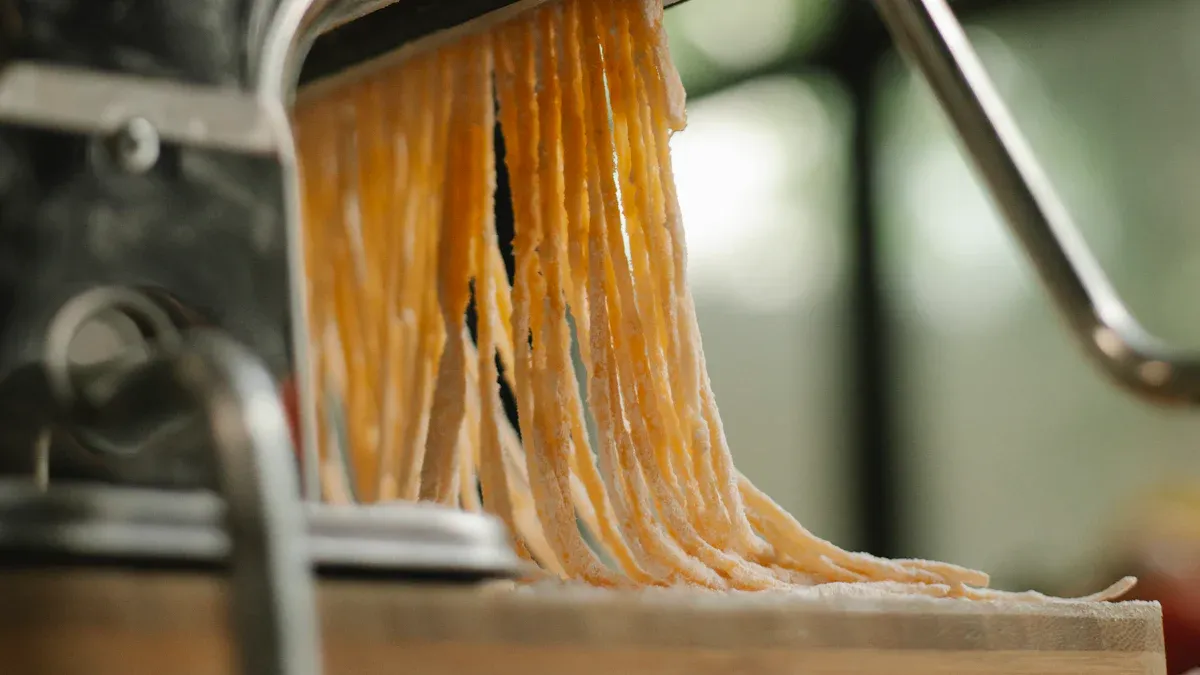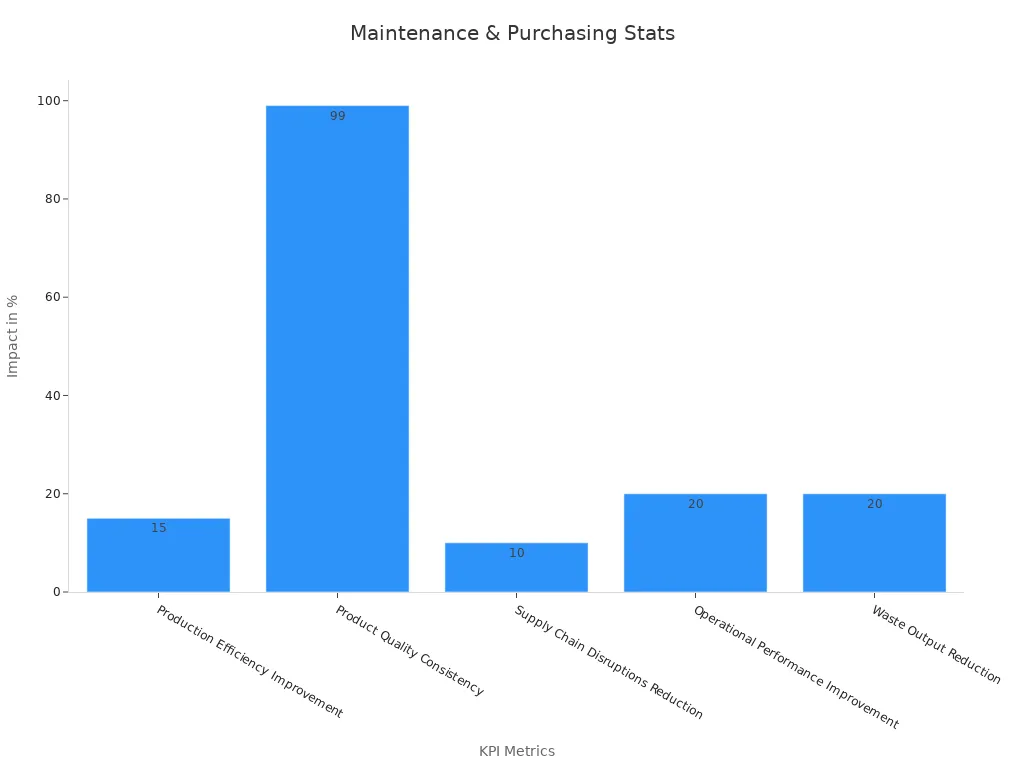© 2017-2018 Shangbaotai Machine Technology (Kunshan) Co., Ltd. All rights reserved. Site Map

A noodle manufacturing machine makes noodles quickly for businesses and homes. This machine helps people who want more fresh and instant noodles. People want these noodles because of new habits and health choices. The market for these machines was USD 2.3 billion in 2024. It is growing fast, as shown below:
Metric/Segment | Value/Projection | Timeframe/Notes |
|---|---|---|
Market Revenue (Global) | USD 1.2 billion | 2024 |
Market Revenue Projection | USD 1.8 billion | By 2033 |
Asia-Pacific CAGR | Over 9% | Through 2033 |
Household Use CAGR | 4.2% | Not specified |
The newest models make 50% more noodles. They also use 25% less energy, as shown in the chart below.
Noodle manufacturing machines can be manual, semi-automatic, or fully automatic. These types work for different business sizes and needs. These machines make noodles better by keeping thickness, width, and texture the same. They also help make noodles faster. Stainless steel parts make the machines easy to clean. These parts also keep the machines safe and strong for a long time. You should pick a machine based on how many noodles you want to make. You also need to think about your space, money, and noodle type. If you take care of the machine and use it carefully, it will break less. This saves money and helps your business get bigger.
A noodle manufacturing machine changes raw ingredients into noodles step by step. First, flour and water are mixed together. The usual ratio is 100 parts flour to 28-35 parts water. Some machines use vacuum mixing technology. This removes air bubbles and makes the dough stronger and stretchier. Dual-axis mixers help spread water and flour evenly. Automatic feeding systems keep the right amount of each ingredient. This helps avoid mistakes and keeps the process going smoothly.
After mixing, the dough goes to rolling and shaping. Machines use 5 to 7 rollers to make the dough thinner. The dough starts at 10-15mm thick and gets rolled down to about 1.0-1.2mm. Laser gauges and pressure controls help keep the dough the same thickness, within ±0.05mm. The rollers are made from food-grade stainless steel. This stops the dough from sticking and keeps things clean. Temperature control systems keep the rollers at the best temperature. These machines can work at 30-50 meters per minute. That is up to three times faster than older ways.
Next comes steaming. The dough moves through a tunnel steamer with three heat zones. The first zone preheats at 60-70℃. The main cooking zone is at 95-100℃. The last zone keeps the dough warm at 85-90℃. Steam moves around to keep the temperature difference within ±1℃. Humidity control stops the dough from drying out or cracking. Steaming time can be set from 2 to 4 minutes. Energy-saving features include heat recovery and automatic water filling. A PLC control system manages steam, temperature, and time. This keeps gelatinization changes within 2%.
Tip: Keeping the process steady makes better noodles and fewer mistakes.
Noodle manufacturing machines can be automated or manual. Automated machines do most steps with little help from people. They use sensors and control systems to mix, roll, steam, and cut noodles. This makes the process faster and more even. For example, the Chow Mein Noodles Making Machine and big pasta machines can make 30,000 to 240,000 packs in 8 hours.
Machine Model | Production Capacity (kg/hour) |
|---|---|
M-440 | 500 - 600 |
M-800 | 1200 |
Manual machines need more work from people. Workers must mix, roll, and cut the dough by hand or with simple tools. Manual machines are good for small shops or homes. They let you change things but make less noodles and are less steady than automated machines.
Automated noodle manufacturing machines make more noodles and keep quality the same. Manual machines give more control and keep old ways, but they are slower.
Manual noodle manufacturing machines are good for small businesses and homes. People use hand cranks or levers to mix, roll, and cut dough. These machines let users pick how thick or wide the noodles are. Many chefs like manual machines for making special noodles like ramen or rice noodles. Most manual models have stainless steel rollers and coatings that stop rust. This helps them last longer and keeps food safe. They work best when you do not need to make a lot of noodles. Manual machines also let you try different recipes.
Note: Manual machines take more work but let you control every step.
Semi-automatic machines mix manual work with powered parts. People put in the ingredients and start mixing. The machine then rolls and cuts the dough. This type is good for small or medium restaurants or shops. They help make more noodles without losing quality. Semi-automatic machines can make instant, precooked, or fresh noodles. Many have stainless steel parts that touch food. This makes them cleaner and stronger. Most can handle 20 to 100 kilograms of dough each hour.
Fully automatic noodle manufacturing machines do all the steps by themselves. They need very little help from people. These machines use sensors and digital controls to keep things the same every time. ANKO is a top brand and has about 6% of the fully automatic noodle machine market. ANKO uses automation, digital tools, and AI to make better noodles and work faster. Fully automatic machines can make many kinds of noodles, like instant, rice, and precooked. They often have settings you can program, automatic portioning, and safety systems. Stainless steel keeps food safe and helps the machine last longer.
Brand/Model | Automation Level | Capacity (servings/hour) | Notable Features |
|---|---|---|---|
ANKO | Fully Automatic | 500–2000 | AI controls, global support |
Yamato (Richmen) | Fully Automatic | Up to 2000 | Portioning, safety, easy use |
Industrial noodle manufacturing machines are made for big factories and companies. These machines can make thousands of servings every hour. Yamato’s industrial models can make up to 2000 servings per hour and keep the noodles high quality. People do not need special skills to use these machines because they have automation and safety features. Industrial machines use stainless steel for all parts that touch food. This makes them last longer and keeps food safe. The noodle slitter market shows that stainless steel stops rust and helps machines last longer.
Machine Component | Stainless Steel Application | Quantitative Detail |
|---|---|---|
Noodle Hanging Rods | Material of rods | Capacity: 4000 pieces |
Measure and Feeding Machine | Contact parts and tank | Volume: 110L |
Double Shaft and Speed Mixer | Food contact parts | Batch size: 150kg, Motor power: 6.5/8kw |
U Type Dough Ripening Machine | Contact parts | Batch size: 200kg, Power: 4kw |
Industrial machines can make instant, precooked, and special noodles. Their big size and smart features make them important for large companies.
Tip: Stainless steel helps machines last longer and keeps food safe.

A noodle manufacturing machine has many important parts. These parts help make good noodles every time. The main parts are adjustable rollers, noodle cutters, flour mixers, and automatic watering trays. Adjustable rollers let you pick how thick the dough sheet is. You can set it from 0.8 to 1.5 mm. The rollers are big and strong, so they press the dough well. Noodle cutters let you choose how wide the noodles are. You can make thin vermicelli or wide udon. Special knives fit into the cutter grooves and stay in place with brackets.
Flour mixers mix the ingredients so they are even. Automatic watering trays add water at the right time. These features help keep the dough the same and stop it from sticking. Many machines use anti-stick systems and dough conditioners for better dough sheets. The table below shows how these features work:
KPI Aspect | Description |
|---|---|
Dough Sheet Thickness | Kept between 0.8 and 1.5 mm during rolling |
Noodle Width Range | From very thin (1 mm) to wide udon noodles (up to 8 mm) |
Pressure Range | Dough pressing pressure set between 10 to 30 kg/cm² |
Speed Adjustment | Speed can be changed to control dough stretch |
Sheeting Consistency | Same pressure and force used for even dough sheets |
Additional Features | Dough conditioners and anti-stick systems help make good sheets |
Noodle manufacturing machines are made to be flexible. You can change the thickness and width with special knobs and levers. These handles make it easy to adjust the machine. Noodle knives come in many sizes. They are easy to put in and stay tight while working.
Some machines have new technology. Auger systems move dough smoothly. Cold water-cooling keeps the dough cool. Special blades cut the noodles neatly. Many machines have flour mixers that control how much dough is mixed. Automatic watering trays add water at set times. These features help you make many kinds of noodles, like ramen, udon, rice noodles, and instant noodles.
Quality and safety are important for every noodle manufacturing machine. Many new models, like those from Wuhan G-YOUNG Industry & Trade Co., Ltd., have CE certification. This means the machine is safe and meets high quality rules.
Noodle manufacturing machines have many good points for users and businesses. One big benefit is efficiency. Machines make noodles faster than people can by hand. They also keep the noodles the same thickness, width, and texture every time. Operators use pressure rollers and digital controls for even results.
Scalability helps businesses make more noodles as they grow. Machines can make more noodles by changing speed and batch size. Operators can switch noodle types with easy changes. Stainless steel makes the machines last longer and keeps food safe.
Tip: Running the machine the same way each time means fewer mistakes and better noodles.
Picking the right noodle manufacturing machine depends on a few things. First, think about how many noodles you need to make. Small restaurants or homes might only need a small machine. Big factories need machines that make thousands of servings each hour. Money is important too. Buying and taking care of machines can be 35-40% of all costs. Space matters as well. Some machines fit on a counter, but big ones need their own area. The kind of noodle you want to make is also important. Some machines are better for ramen or udon. Others work best for rice or instant noodles. Make sure the machine’s features match what you need, like how much it can do by itself or if you can change settings.
Operators can work better and make good noodles by following some tips. Always read the user manual before using the machine. Check the ingredients and settings often to stop mistakes. Listen for strange sounds or look for changes in the dough. Real-time monitoring systems help find problems fast. Fixing things quickly keeps the machine running well. Doing regular maintenance stops the machine from breaking down. This helps the factory keep working. Checking how the machine works every month can make it 15% more efficient. Keep a notebook of problems and how you fixed them for next time.
Tip: If you cut machine downtime by 5%, you can make more noodles and earn more money.
Taking care of the machine helps it last a long time. Each year, maintenance costs are about 5% to 10% of what the machine cost to buy. For example, a $10 million factory might spend $500,000 to $1 million on maintenance each year. The table below shows common costs:
Expense Category | Impact on Budget | Frequency |
|---|---|---|
Equipment Purchase & Maintenance | 35-40% of total costs | Annual reviews, ongoing |
Technology Upgrades | 10-15% of capital | Every 3-5 years |
Operators should check the machine often and use special tools to find problems early. Keep extra parts ready in case something breaks. Safety training is very important. Well-trained workers can find problems early and stop accidents.
Noodle manufacturing machines help all kinds of businesses work better and safer. They make noodles that are always the same quality. People who use these machines get many benefits.
The machines keep making noodles without stopping and are simple to use.
Their small size means they do not need much space.
AI helps control noodle quality and saves money.
Picking the right machine and taking care of it helps a business do well for a long time. The table below shows how good care and smart buying help businesses:
Metric / KPI | Impact / Benchmark | Explanation |
|---|---|---|
Product Quality Consistency | 99% consistency rate | Noodles look and taste the same, so customers are happy. |
Waste Reduction | 15-20% annually | Making less waste saves money and helps the planet. |
Revenue Growth | Up to 15% increase | Making more noodles helps the business earn more. |

Tip: Think about what you need and talk to experts before you buy. If you take care of your machine, your business can grow and your customers will stay happy.
A noodle manufacturing machine can make many kinds of noodles. These include ramen, udon, rice noodles, instant noodles, and vermicelli. Some machines let you change settings for different shapes and thicknesses.
Operators need to clean the machine after each use. Cleaning stops dough from building up and keeps food safe. Most companies say to do a deep clean once every week.
Most fully automatic machines are easy to use. Operators just follow steps on a digital screen. Training only takes a few hours. Many brands give video guides and help if you need it.
Modern machines have safety guards and emergency stop buttons. They also have automatic shut-off systems. These features help keep operators safe. Many machines use sensors to find jams or overheating.